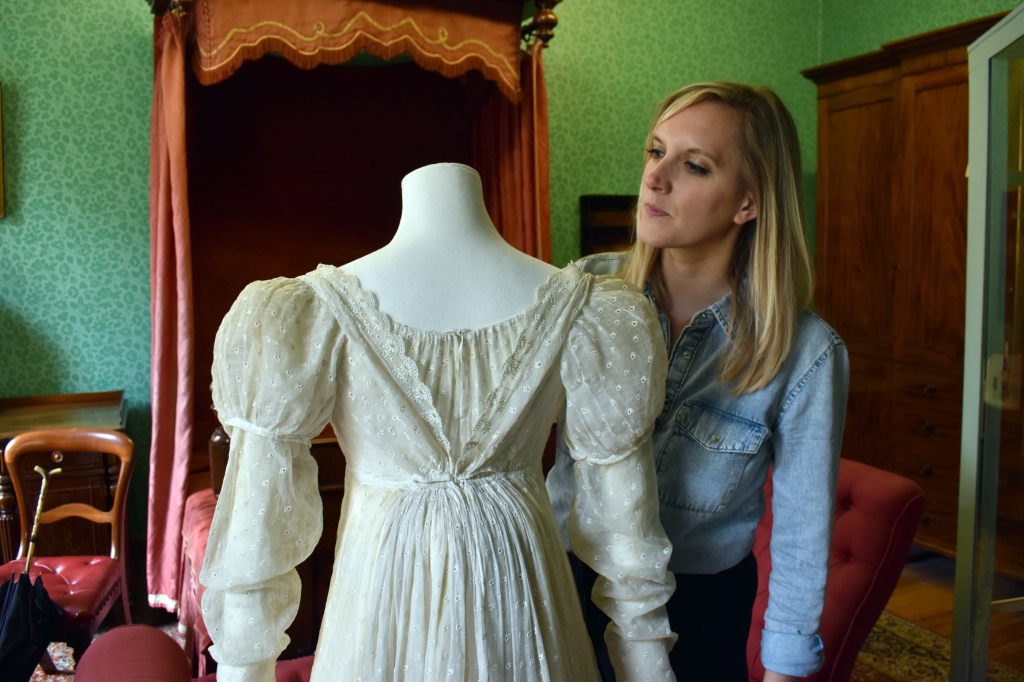‘Her dirty petticoat quite escaped my notice‘. Mr Darcy, Pride and Prejudice by Jane Austen, 1813
Dearest Gentle Reader, when you think of Regency England in novels like Pride and Prejudice or Netflix tv series Bridgerton, what do you think of? Is it delicious period dramas showing the heroine in beautiful high waisted dresses and perhaps Colin Firth as Mr Darcy?
The new Style and Sensibility exhibition at Judges Lodgings in Lancaster reveals the reality of historic fashions from 1800-1830s through dress, accessories and prints. And it turns out that Regency style is as pretty as we imagine, even if the full story is a little bit more complicated.
Jane Austen’s famous novels were published during the Regency period (1811-1820) when the Prince Regent ruled in place of his father King George III, then incapacitated by mental illness. Her novels give us a fictional England of polite drawing rooms and brilliant but understated social comedy.
Yet Jane Austen rarely mentioned clothes in her famous novels, though she often talked about them in her letters. Books like Pride and Prejudice suggest Austen disapproved of high fashion and appreciated natural, classical elegance. As she wrote in her 1815 novel Emma, ‘My natural taste is all for simplicity; a simple style of dress is so infinitely preferable to finery’.
Early 1800s fashions were a massive contrast compared with much of the previous century. Heavy, patterned materials were replaced by light, simple fabrics. Art, fashion and furniture design were influenced by the classical styles of Ancient Greece and Rome. Excavations at Roman Herculaneum (after 1738) and Pompeii (after 1748), and the sculpture seen by wealthy young men travelling on their Grand Tour of Europe, influenced British style. The British Empire too brought change. High waisted dresses may have been an Indian influence as wealthy Britons came home with new ideas and materials from Asia.
The new exhibition features a jolly poem poking fun at high waists (on loan from Lancashire Archives):
Shepherds I have lost my waist. Have you seen my body?
Sacrificed to modern taste, I’m quite a Hoddy Doddy.
Never shall I see it more, Till common sense returning
My body to my legs restore, then I shall cease from mourning
For fashion I that part forsook where Sages plac’d the belly
Tis lost and I have not a nook for cheesecakes, tarts or jelly!
Politics and conflict in this age of revolution also impacted fashion. The French Revolution’s ideals of equality and liberty brought fresh interest in the democracies of Ancient Greece and Rome. Revolution in France was soon followed by war in Europe. Military styles came became fashionable. Napoleon’s campaigns in Egypt, Spain, Poland, Russia and Prussia, created crazes such as turbans, ‘slashed’ Spanish sleeves and luxurious fur.

Image 2: Fashion plate showing Full Dress for April 1808. Thanks to the Harris, Preston.
Regency fabrics were linked to colonial trade with India, China and the Americas. Lancashire’s textile industry was fed by raw cotton harvested by enslaved Africans.
The Style and Sensibility exhibition at Judges Lodgings features Lancashire pattern books from the 1830s containing colour recipes and samples of fabric dyes. Some dyes were from ‘logwood’ and ‘fustic’ trees harvested by enslaved Africans in the Caribbean and South America. In Jane Austen’s novel Mansfield Park, Sir Thomas Bertram is away at the West Indian slave plantation which pays for his family’s idle lifestyle.
So how did fashion and trade affect wealthy women in Lancashire? While gentry women in Lancashire were less likely to follow the extreme styles of London’s fashionable elite, they still had a taste for high waists and fine fabrics.
The Judges Lodgings exhibition features a beautiful evening gown worn by Ann Paiton to the Preston Guild Ball in 1822. The dress is made from silk and has original fashionable layers of decoration on the skirt.

Image 3: Dress worn by Ann Paiton to the Preston Guild Ball in 1822. Thanks to the Harris, Preston.
A fashionable white cotton dress dating from 1810-1820 and worn by Maria Hulton is also on display. Maria’s husband was William Hulton, High Sheriff of Lancaster and the man who ordered the infamous Peterloo Massacre of working-class people in Manchester in 1819. Both dresses are on loan from the Harris, Preston.
So, Dear Reader, our idealised vision of Jane Austen’s England, and Regency fashion, was in reality a place affected by class conflict, colonial trade and a re-imagined ancient past. And perhaps it’s a more compelling story for all that.
Visit Style and Sensibility – Regency Costume 1800-1830s at Judges Lodgings Museum
Thursday 27 June – 17 November 2024
Judges Lodgings is open Thursday, Friday, Saturday, Sunday
Style and Sensibility – Regency Fashion exhibition – Lancashire County Council

